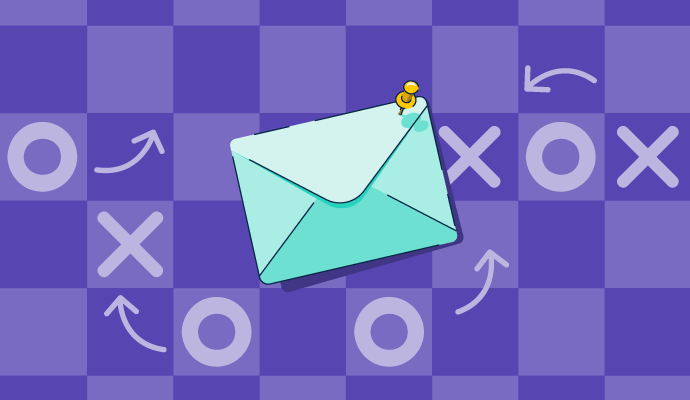September 30, 2022
 by Phil Newton / September 30, 2022
by Phil Newton / September 30, 2022

So, you’ve used G2 to find the best email marketing software for your business, maybe you have an email list with potential customers eager to learn about your brand. You might have even sent a few emails to these recipients, but quick question – what happens now?
Answer: you take your campaign to the next level with a well-designed email marketing strategy!
An email marketing strategy is a set of procedures and action points that marketers follow to improve communications with the people of their email list and reach their desired goals. It essentially provides a blueprint for achieving goals through email marketing - think of it as the what, why and how of leveling up your email marketing game.
In this guide to building a winning email marketing strategy, we’ll cover email marketing strategy benefits, the top 10 things to consider when building out your email marketing strategy, and a bonus knowledge share from direct experience building email marketing strategies. Let’s go!
Money talks, right? Research shows that email marketing boasts a higher return on investment (ROI) than any other marketing channel, yielding a 42x return on every dollar spent. To get these results, you need a full marketing plan. It’s not enough to just manually send emails every once in a while with no clear template in place or knowledge of best practices for email marketing.
Email marketing is different from social media marketing, direct-mail marketing, search engine optimization (SEO) or any other kind of marketing that’s popped up since the turn of the millennium. It provides a direct link to your email list, allowing you to send personalized, relevant and valuable content directly to your subscribers.
No other marketing channel lets you use the information you know about an individual to curate content that’s so valuable that they simply must engage. Yes, email is powerful, but, as the saying goes, “with great power comes great responsibility.” Therefore, learning how to harness this power in an effective and engaging way is key to your email marketing campaign’s success.
Sound good? Read on to learn about our top 10 email marketing tips to help you build the best strategy for your brand.
Unlock the full potential of your email campaigns with the best email tracking tools. Monitor performance in real time and gain actionable insights.
Below we’ve outlined 10 things that we always take into consideration when building out an email marketing strategy to improve email list engagement, decrease unsubscribers, and increase conversions.
You can’t build a good email marketing plan without knowing who makes up your email list. A customer journey map creates a story for each of your customers with an accompanying visual flow of their activities, interactions and touchpoints with your brand. This helps you identify opportunities to enhance their experience using email marketing.
As you build out your customer journey map, think about:
Once you have a visual representation of all of the above, you should be able to identify spots in the customer journey where you can alleviate a pain point, address a drop-off point, or enhance the experience to help them along their way to conversion.
Segmentation in email marketing is crucial for the success of your email marketing strategy. If you don’t segment, then you’re including all of your recipients in a one-size-fits-all email marketing strategy model that’s going to spam your potential customers with a lot of irrelevant content. Those emails are going in the trash.
To truly harness email marketing segmentation, you need to market to an audience of one, meaning that you look at all the different demographic and behavioral data you have about your users and use it to segment them into ever more specific and targeted groups, with the aim to send content completely tailored to each individual that comprises your recipients list.
Some email segmentation ideas include:
Email segmentation goes hand-in-hand with email personalization, so it’s only natural that we include this.
Research shows that 90% of consumers find personalized content very or somewhat appealing, and 91% of consumers are more likely to patronize businesses that provide recommendations and offers that are tailored to them. An experiment also concluded that, when an ad based on site activity was shown to consumers, click-through rates increased by 11% and revenue from the product grew by 38%.
Where do you get started with personalizing your email marketing campaigns? Good question! Try out these methods.
Having a clean email list increases your sender reputation with email service providers (ESPs) like Gmail, Outlook, Yahoo, and AOL. A higher sender reputation means that your email is more likely to be successfully delivered to the recipient rather than return an email soft bounce or hard bounce error (where the email ‘bounces’ back to you instead of being delivered to the recipient).
A good reputation also increases the chance that the email drops into the recipient’s inbox, rather than being filtered into their spam folder. This practice is called email deliverability.
As more recipients are likely to see, trust, and open your email if it’s delivered into their inboxes, deliverability is directly correlated to increased email engagement levels, and therefore a higher ROI. Although many factors play into overall deliverability of your emails, email list hygiene is important, so regular email list cleaning or email scrubbing should be high on your email marketing strategy practices.
Some quick pointers on what to for when you’re tidying up your email list include:
Automation is key to scaling your email marketing strategy
A 2022 study found that utilizing email automation to send triggered emails resulted in 71% higher open rates and 102% higher click-through rates than their non-triggered counterparts, so it’s clear that email automation is key to maximizing the ROI of your email marketing strategy. Let’s get into the nuts and bolts of email automation so you can figure out how to best use it to your advantage.
Email automation is the automated sending of one or a series of emails to a recipient based on their recorded actions or events, known as “triggers”.
Some of the most common email automation triggers include:
Email automation allows you to reach the right person with the right message at the right time without doing the work every time. The best part? It’s totally scalable; once you’ve set the triggers, they automatically send relevant emails to any user who triggers them, whether that’s 10 users or 10,000.
Something to note here is that not every ESP is capable of setting up triggers. If this applies to you, check out our recommendations on the best marketing automation software and also explore the many benefits of marketing automation that can meet your individual needs.
Providing return on engagement for your recipients will boost engagement rates and help to mitigate unsubscribes.
Just as you need ROI from your email marketing strategy, your audience needs return on engagement. What do they get in exchange for sharing their contact details with you?
As you’re building out each campaign, think about how your business fits into your base’s lives to help them solve their problems or reach their goals. Then, write high-quality, customer-centric content that provides real value back as a reward for their email open. Put the customer first, not the product.
Some types of return on engagement you can offer your email list include:
The email subject line is the first thing your recipient sees when your email drops into their inbox. You can create the world’s best email, but if the subject line doesn’t spark the recipient’s interest, they’ll never see your message. The subject line opens the door to the valuable content inside your email, and if that door stays closed, you’re not going to get the ROI you expect.
Here are some top tips for writing the best email subject line:
Bonus tip! Don’t forget about your email preheader text. This is an important and often overlooked part of your inbox view. Essentially, it’s a second subject line that can be used to add additional information, context, or intrigue that supports your subject line.
We go further into writing the best email subject lines in this article.
Experimentation drives good email marketing strategies. It helps you stay relevant and engaging to your audience by continually iterating on past learned behavior. If you’re not testing new ideas in your email marketing plan, then you’re not moving forward!
Experimentation should be ingrained in the culture of your plan. If an idea doesn’t go the way you’d hoped, fear not – it’s just as important to know what your audience doesn’t engage with as it is to know what they do. Either way, you get insights to help you shape the evolution of your email marketing plan.
Not sure where to get started with email testing? Here are 5 steps to email marketing experimentation:
You’ll repeat these steps as you try out more experiments.
Tracking email marketing metrics helps measure the success of your email marketing strategy
Tracking email marketing metrics is how you measure the success of your email marketing strategy and its individual components. By taking an aggregated look at your campaign metrics, you can get a top-level view of how your overall strategy is performing. Then, by studying individual campaign metrics, you can identify any strong or weak points along the way and see what you can learn from them.
So, what metrics should you be looking at when measuring the success of your email marketing strategy?
You have to ensure that everybody in your email list is able to understand and take action on the contents of the email campaigns that form your email marketing plan.
This means making sure that your emails:
After all, what good are high delivery rates, world-class subject lines, and valuable and engaging content if the email’s design is skewed when it’s opened, a button doesn’t work, or a portion of your audience is unable to navigate through your email? Ticking all the boxes here is imperative to the success of your email marketing strategy.
Awesome! You’ve made it through our top 10 best email marketing tips for a successful strategy and hopefully learned some new things to take back to your boss who should shower you in praise, in awe of all the new things you bring to the table.
As a bonus for making it this far, here are some insights on common mistakes that you’ll want to avoid while building out your email marketing strategy.
We get it. You’re excited. You cannot wait to dive in and start implementing everything you’ve read here. But taking on too much at once when trying to improve your email marketing strategy could actually have the opposite effect. So before you go all-in and start to tackle each one simultaneously, go over these recommendations:
An email marketing strategy should be a living, ever-evolving thing. Don’t fall into the same trap that many have before you by successfully executing a strategy then putting your feet up and thinking that the job’s done. What delights and engages your audience today may not be the same in 3/6/12 months’ time. We get bored. You need to continually try new things to evolve your strategy with the needs, wants, and likes of your audience in mind.
Your email needs to deliver what it promises. If you write a subject line that entices your recipients to open the email, only to disappoint them with copy that’s not relevant or underdelivers on your promise, then not only will your engagement rate suffer, but it can affect how people view and trust your brand. This is also a surefire way to annoy your recipients into unsubscribing, or worse - marking your email as spam.
Just because you have information on a recipient doesn’t mean that you have to use it. That’s creepy. You’ll scare your recipients into unsubscribing!
When you’re building out your email campaigns, think about the goal of each campaign and what information is required to add relevant value to your email to help reach that goal.
Now that you’re equipped with all the knowledge you need to take your email marketing strategy to the next level, it’s time to put what you’ve learned into action!
Remember that every brand’s starting points, needs & wants are different; the tips that we’ve shared here are meant to serve as a guide and provide inspiration so you can implement relevant changes to your own email marketing strategy that will make a real difference. You’ve got the blueprints, now go forth and build!
Ready to choose a tool that can help take your strategy to the next level? Check out the 23 best email marketing platforms.
Phil is a Senior Email Marketing Specialist at G2. As a full-stack email marketer and self-confessed email geek, Phil has years of experience designing, building and managing email marketing strategies for B2C and B2B businesses of all sizes. He currently heads up user-side email operations at G2 where he is committed to building the most engaging, joyful, and memorable email experiences to our users.
Most people send emails under the general assumption that they’ll be delivered.
 by Antonio Gabric
by Antonio Gabric
Attention spans are shrinking. Data helps your emails make every second count.
 by Alexander Cartigan
by Alexander Cartigan
Are you getting maximum utility out of your email marketing efforts?
 by Jonathan Herrick
by Jonathan Herrick
Most people send emails under the general assumption that they’ll be delivered.
 by Antonio Gabric
by Antonio Gabric
Attention spans are shrinking. Data helps your emails make every second count.
 by Alexander Cartigan
by Alexander Cartigan


